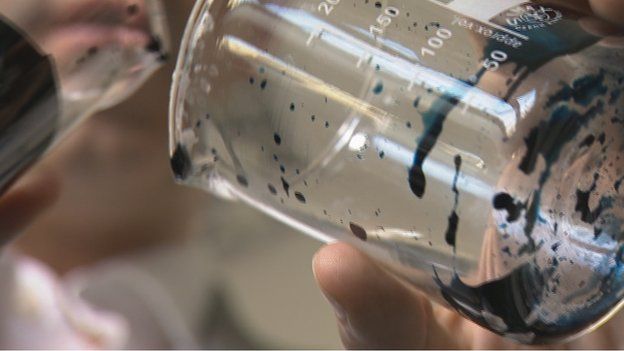Fast, clean, green, cheap: Is this our hydrogen fuelled future?
- Published

Don't try this at home. Seriously.
But were you to pass an electric current through water you'd see bubbles start to form. That's good old H2O breaking down into its constituent oxygen and hydrogen as electricity breaks its bonds.
Hydrogen is the lightest element in the Universe. More pertinent to our needs, it's a carbon-free fuel. When you burn it you simply get heat and water.
There's considerable buzz around hydrogen's capability to deliver clean energy, either by burning it or using hydrogen fuel cells.
But the dominant method for producing the hydrogen we use today is not clean. Most of it is derived from methane in a process which uses fossil fuels and creates greenhouse gases.
At Glasgow University, Prof Lee Cronin thinks he and his team have come up with a game changer.
It's a process 30 times faster than the existing leading process which uses electricity to make hydrogen from water.
Currently the most advanced process is to use proton exchange membrane electrolysers (PEMEs). But even the highest performing PEMEs need catalysts made of precious metal, high pressures and plenty of electricity.
Prof Cronin and his colleagues at the university's Solar Fuels Group say their new method allows more hydrogen to be produced than ever before, with lower power loads and at normal atmospheric pressure.
And there's more, as they reveal in a paper in the journal Science.
Instead of remaining a gas - which requires high pressures and low temperatures to store - the new process stores the hydrogen in a carbon-free liquid.
It's done by using a "liquid sponge" - a metal oxide that starts yellow, then turns blue as it's loaded with hydrogen, or more correctly the potential to create hydrogen, as it holds its constituent protons and electrons.
Prof Cronin holds up a beaker of blue liquid: "What you do is just turn on the electricity and you split water and you produce this liquid.
"When you want to produce the hydrogen, you don't have to add any more electricity.
"You just pour this over a catalyst and out comes the hydrogen. And it comes out 30 times faster than the equivalent commercial device."
So far, so startling. But while the process itself represents a breakthrough, the possibilities which flow from it are even more intriguing.
Renewable energy
Scotland is rich in potential sources of renewable energy: solar, wind and wave.
But sometimes when energy is needed most, the wind isn't blowing or it's dark. If only we could store this intermittently bountiful energy in huge quantities.
The most common way of doing this at present is pumped storage: when energy is plentiful, use it to pump water uphill to a reservoir, then when extra energy is needed let it flow back downhill again, generating hydroelectricity on the way.
But there are only so many glens you can flood and the engineering costs are high.
Prof Cronin's method offers a different future. Electricity from renewable sources would be used to split water, harvest the hydrogen and store it in a liquid for use when it's needed.
There are of course caveats, not least the fact that this process is still in the laboratory .
Prof Cronin says it'll take time and money to scale it up to an industrial process: "I think for making something that's going to get into a really large system, it's going to take up to ten years.
"Hopefully we'll inspire a company to get started and put the technology in that company."
The process has already been patented and Scottish Enterprise have provided financial support to develop it.
Salt and water
Prof Cronin envisages another development: replacing the metal salt in the storage liquid - and the expensive precious metal in the electrodes - with carbon.
"The idea would be to make a very small, low power, completely carbon-based organic system for mobile phone power and small low power devices," he says.
"And if we can get that to work, we may take that to market first."
But it's the possibility of large scale energy storage which holds out the possibility of greatest change.
"We need to do it in Scotland because it's a great showcase for getting renewable energy solutions to work.
"We need storage, and we need that infrastructure to be built."
This could be the first step towards a cheap, green, stable and reliable way of fully exploiting Scotland's renewable energy potential.
Even when the Sun doesn't shine and the wind doesn't blow.